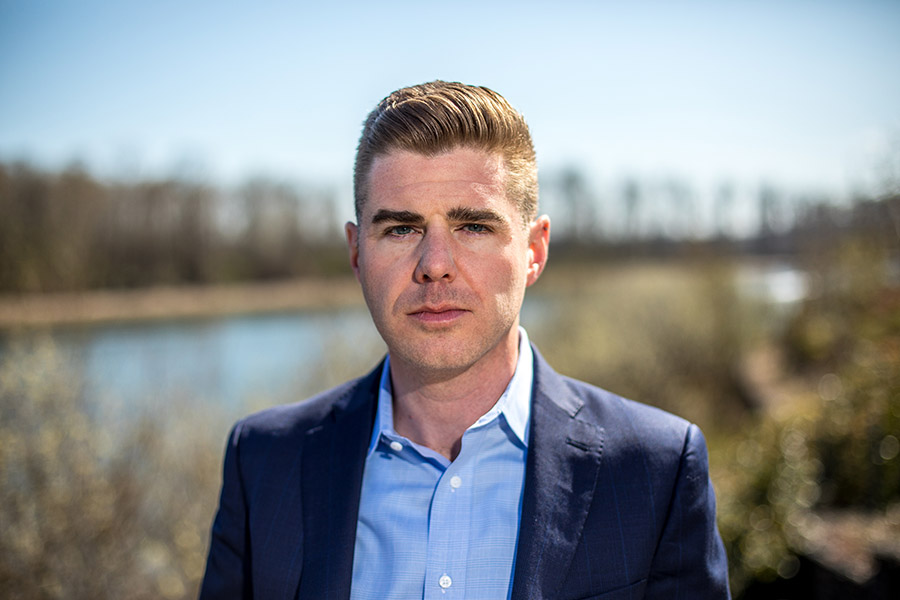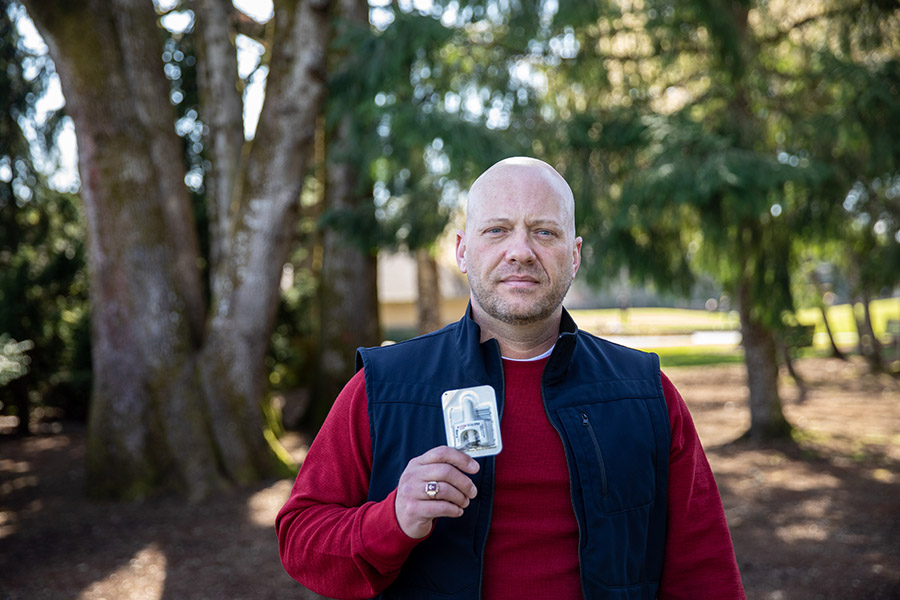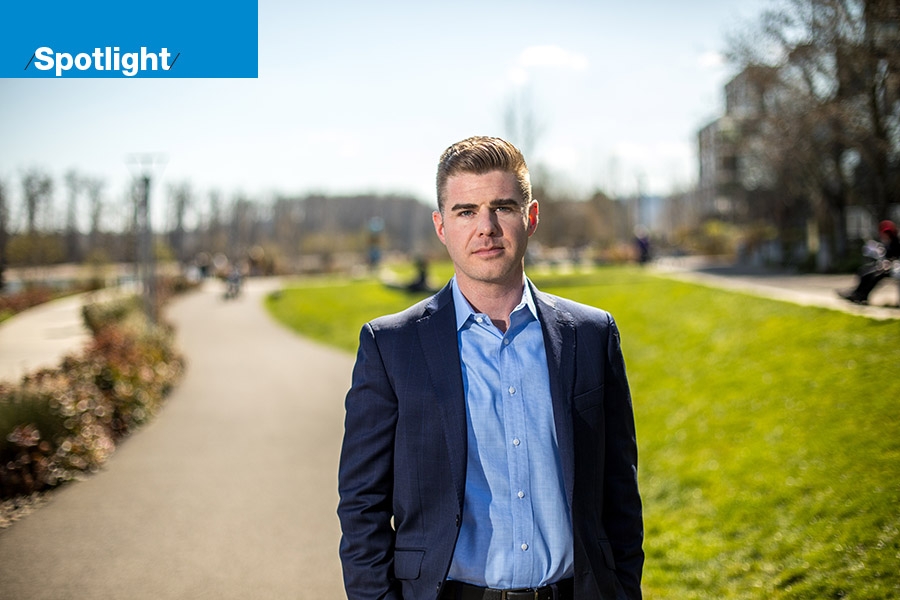Employers can play a key role in helping employees recover from drug and alcohol addiction. Yet assistance programs are few and far between.
Hans Bernard remembers a particular Wednesday in mid-November of 2015 vividly. Disoriented and hungover, he called in sick. He got high again and then fell asleep. But then he did something that changed his life forever: He called a rehabilitation facility in Newberg and checked himself in for 45 days of treatment shortly after.
“I had failed to pay bills. My life outside of work was totally chaos,” says Bernard, a soft-spoken man with coiffed hair and a big smile. He had tried rehab in 2011, but it did not stick. “I would sit at home and wait and wonder, like, when is the knock at the door going to come and the intervention going to happen?”
The 37-year-old from Alaska works as the assistant vice president for state affairs at the University of Oregon. Like many people, he experimented with alcohol and drugs when he was in college. But unlike most of his peers, he could not stop.
“It was the stresses of everyday life,” he says. “Relationships, work, and as an addict, once I started to utilize those substances, they very quickly became go-to coping mechanisms.”
 Hans Bernard is the assistant vice president for state affairs at the University of Oregon. He has been sober since 2015.
Hans Bernard is the assistant vice president for state affairs at the University of Oregon. He has been sober since 2015.
Oregonians experience one of the highest rates of substance abuse in the nation. Four people die every day from alcohol and other drug use, according to the State of Oregon Alcohol and Drug Policy Commission.
And according to the National Council on Alcoholism and Drug Dependence, more than 70% of people addicted to alcohol and drugs are employed.
Today Bernard has been sober for more than four years. For many, becoming sober means getting the right help at the right time. Some businesses in Oregon offer employee-assistance benefit programs or partner with community organizations to bolster prevention and intervention services.
But for too many in the state and across the country, addiction treatment is hard to navigate, expensive and not always an option.
Assisting workers with their addiction not only improves the health and wellness of that specific employee, but also boosts overall company morale and can end up saving the business financially in the long term.
In fact, according to the National Clearinghouse for Alcohol and Drug Information, addiction in the workplace costs U.S. employers $100 billion annually from lost productivity, increased workers’ compensation claims and more.
When Bernard decided to enter residential treatment at Hazelden Betty Ford Foundation, he says his employee benefits allowed him to choose between taking medical leave as well as using his accrued vacation time.
“I think my employer — both my boss in particular, but my employer [overall] — recognizes that people who are struggling with addiction are going to be much better employees if they seek services.”
The University of Oregon, which has more than 600 employees, has both medical insurance benefits and an employee-assistance program that covers alcohol- and drug-abuse treatments.
Bernard says that if it was not for his benefits, his treatment would have cost him between $50,000 and $60,000. Upon leaving rehab, he was also prescribed medication to reduce cravings, which would have cost an additional $1,500 to $2,000 out of pocket.
Employee-assistance programs are particularly helpful for those experiencing addiction. These programs can include confidential counseling (both over the phone and in person), outpatient and residential treatment, and recovery support.
For high-stress, physically demanding industries such as construction, such benefits can make all the difference. Electrical contracting company EC Electric, which has more than 1,000 employees and locations in Oregon and Washington, has an employee-assistance program for both its union and nonunion employees.
“If somebody came to us with a problem or they test positive on a random drug screening, we didn’t just fire them,” says Warren Jackson, the former environmental health and safety director.
 Warren Jackson holds a pack of Narcan nasal spray, which can reverse an opioid overdose. He always keeps some in his pickup truck. Photo: Jasaon E. Kaplan
Warren Jackson holds a pack of Narcan nasal spray, which can reverse an opioid overdose. He always keeps some in his pickup truck. Photo: Jasaon E. Kaplan
Originally from southern Illinois, Jackson has spent much of his career in the construction industry. Before leaving the company in February, he says he aided seven employees experiencing addiction — mainly for alcohol — including getting them treatment and sometimes even reassigning them to different projects.
But companies like the University of Oregon and EC Electric seem to be the exception; many of Oregon’s small businesses often do not have the bandwidth to include employee-assistance programs or premium insurance plans.
As a result, many people with addictions lose their jobs. According to a National Survey on Drug Use and Health, 17% of unemployed workers, or one in six, have an alcohol or drug addiction.
The state knows it is a problem. Two years ago, in 2018, Gov. Kate Brown declared addiction a public health crisis in Oregon. To address the state’s record-high rates of alcohol and drug abuse, Gov. Brown convened a task force.
This year, the Oregon Alcohol and Drug Policy Commission developed a five-year, statewide strategic plan. Yet another team is now being formed to implement the plan.
“There hasn’t been a strong force advocating for prevention and treatment,” says Mike Marshall, the co-founder and director of Oregon Recovers, a Portland coalition working to improve addiction treatment across Oregon.
Marshall is a regular presence at the Capitol when legislators are in session to advocate for systematic changes in Oregon health policies.
The state has managed to launch prevention and intervention programs targeted at helping those experiencing tobacco, alcohol or drug addictions, but the state commission found there was “little coordination among the state agencies and providers responsible for administering funding, strategies and services.”
Businesses are often charged with implementing their own intervention, treatment and recovery initiatives. When Jackson worked at EC Electric, he had nine of the company’s 18 environmental health and safety professionals partner with Cascade Training Center in Portland to undergo emergency medical responder training.
They learned the warning signs of someone having an opioid overdose and now carry Narcan — a 2-inch naloxone nasal spray that reverses overdoses — with them everywhere. In fall 2019, the Oregon Health Authority launched its own program, Reverse Overdose Oregon, to similarly provide businesses with naloxone training with the aim of preventing opioid overdoses.
“As a safety professional, Narcan has become no different than an AED or a fire extinguisher,” says Jackson.
Jackson’s passion to tackle opioid abuse is not only professional, it is personal. (He left EC Electric to pursue work as a consultant to help businesses integrate naloxone training.) His son Zach died of an opioid overdose when he was 27, after battling his addiction for 10 years.
“We exhausted our retirement accounts trying to help with recovery and treatments,” he says of him and his wife. Jackson says Zach was found in a vacant field near a gas station in their Illinois hometown. “I always thought if that gas station or that employee would have had Narcan, maybe there was a chance,” he says. “That’s something that’s always out there.”
The company’s safety professionals have already benefited from their training. Last fall a contractor working in Hermiston became unconscious after overdosing and was revived after receiving the lifesaving drug. And this January, Jackson himself administered Narcan to an unknown person outside of McMenamins Tavern & Pool after dinner with colleagues.
“If we can prevent one family from experiencing what my family has gone through, it’s worth it,” he says.
While funding and appropriate training are necessary to combat Oregon’s pervasive problem with alcohol and drug addiction, advocates says the stigma surrounding it also must change. “Addiction reaches everyone,” says Jackson. “You’ve got federal judges and well-respected people who are suffering from this.”
In the U.S., alcohol and drug abuse is still frequently considered a moral failing rather than a medical condition. In industries such as construction that adhere to drug-free policies, asking for help can be complicated.
“Members are more willing to talk to us about alcohol and prescription drugs,” says Zack Culver, the business manager of Laborers Local 737 union, which has more than 2,000 members. “They don’t feel like it’s a safe place to talk about [other drug use] with the union because we’re a drug-free workplace.”
When Bernard got treatment for the second time in 2015, he made the decision to tell everyone about his addiction. He continues to share his story with the aim of spotlighting how employers can help and retain workers but also reduce the stigma of addiction.
“It’s a choice that I’ve made that I feel very fortunate to be in a position to be able to have made,” he says. “But at the same time, when you ask someone to describe an alcoholic, most people will go to a 55-year-old man with a bottle in a bag lying on a sidewalk. It’s not me.”
What Needs to Change
Nonprofits such as Oregon Recovers and government taskforces such as the Oregon Alcohol and Drug Policy Commission know the state is in the midst of a health crisis. Here are their main recommendations:
• Implement a statewide system that streamlines alcohol and drug addiction policies and programs.
• Increase prevention strategies.
• Increase access to effective treatment across all age groups.
• Increase access to recovery support across all age groups.







